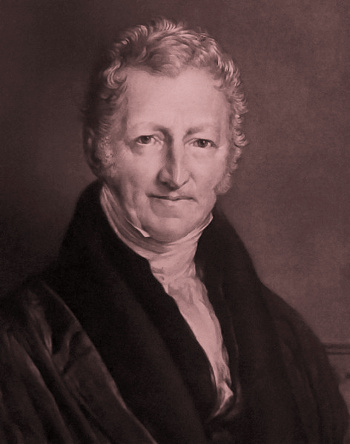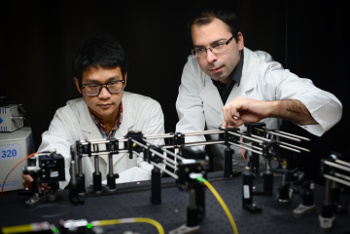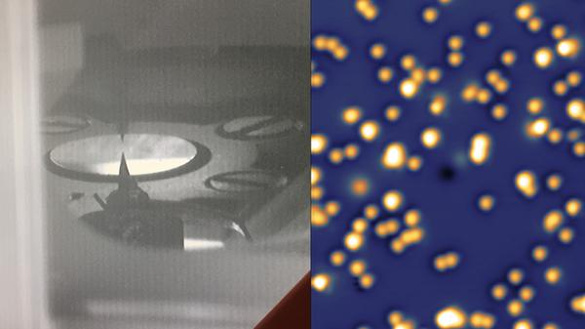The Limits of Memory
August 27, 2018
One important concept in
thermodynamics is the
thermal reservoir, a
thermodynamic system having an
infinite capacity for heat. When such a reservoir is in
thermal contact with another system, its
temperature remains constant since its infinite heat capacity allows it to source or sink as much
heat as is required for this
thermal equilibrium.
Up until the
modern age,
human population was small, so
man was free to take as much from the
Earth as he needed, and to
dump as much
waste as needed, without damaging his local
environment. There was always another
ore deposit to
mine, another
fertile field to
plow, and a place deep in the
woods away from your
house where you could dump your
trash. The Earth was acting as a
resource reservoir, remaining stable against these minor insults.
Today, such is not the case, since the
world population is nearly eight billion. This problem was nicely explicated in 1972 in a
Club of Rome report entitled,
The Limits of Growth. This idea that population growth would be limited can be traced back to
Thomas Malthus (1766-1834). In his 1798 publication,
An Essay on the Principle of Population, Malthus realized that population increases
geometrically, doubling in a certain time period, but
food production grows
arithmetically; that is, at a
linear rate.

Thomas Malthus (1766-1834).
Malthus' publication of An Essay on the Principle of Population was done anonymously.
According to his simple model of population and food production, the world would inevitably reach what is now called a Malthusian catastrophe in which population is abruptly decreased by famine to a new equilibrium state.
I was quite impressed by Malthus when I read about him while I was in high school, since this was my first introduction to mathematical modeling.
(Detail of an 1833 portrait by John Linnell (1792–1882) in the collection of the Wellcome Trust, via Wikimedia Commons, modified for artistic effect.)
In their quest to provide us with better
computing resources,
computer scientists,
electrical engineers, and
physicists have wrestled with other limits of
nature. They're now able to pack tens of billions of
transistors onto a
computer chip the size of a
fingernail. Although
Moore's law predicts a doubling of the number of transistors on such a chip size every two years,[1] we're close to the point at which such improvement will end. The problem, of course, is that we're getting too close to
atomic dimension.[2-3] Echoing a Mathusian sentiment,
Gordon Moore, who created his
eponymous law in 1965, has said,
"It can't continue forever. The nature of exponentials is that you push them out and eventually disaster happens."[3]
While transistors are used for both computing and
memory functions, there are other ways to create a
data memory. I discussed
optical and
magnetic memory
technology in two previous articles (
Optical Memory, January 6, 2012 and
Magnetic Memory, January 19, 2017). Now, scientists are investigating whether single
atoms, or just a few atoms, can be used as data cells in optical and magnetic memories. Such a stretch in technology is important because of the present
exponential growth of collected data.
A team of
Australian scientists from the
University of South Australia (Mawson Lakes, Australia), the
University of Adelaide (Adelaide, Australia), and the
University of New South Wales (Canberra, Australia) have investigated optical data storage in
rare-earth doped inorganic insulators, and they've had good results using
nanocrystalline BaFCl, an
alkaline earth halide, doped with the rare earth element,
samarium, as a multilevel re-writable data storage
material.[4-5] Says
Nick Riesen, a
Research Fellow at the University of South Australia and the leader of this research project,
"With the use of data in society increasing dramatically due to the likes of social media, cloud computing and increased smart phone adoption, existing data storage technologies such as hard drive disks and solid-state storage are fast approaching their limits... We have entered an age where new technologies are required to meet the demands of 100s of terabyte (1000 gigabytes) or even petabyte (one million gigabytes) storage. One of the most promising techniques of achieving this is optical data storage."[5]
This optical memory functions by use of
lasers to change the
electronic state of the samarium atoms, and this changes their
fluorescence.[5] Sm
3+ is converted to Sm
2+ upon exposure to
ultraviolet light. The
photoluminescence of the Sm
2+ contains the data, and its
intensity depends on the intensity of the ultraviolet light during the writing step. The intensity can code multiple bits of data, so each nanocrystal is a multilevel data storage cell.[4]
Since the optical reading and writing is done using
confocal optics, the optical memory isn't limited to a
two-dimensional array. It can be designed for
three-dimensions, giving it a potential density of a petabyte/cm
3.[4-5] It's estimated that a
human brain can store about 2.5 petabytes.[5] Says
Heike Ebendorff-Heidepriem, a
professor at the University of Adelaide and a member of the research team,
"We think it's possible to extend this data storage platform to 3D technologies in which the nanocrystals would be embedded into a glass or polymer... This project shows the far-reaching applications that can be achieved through transdisciplinary research into new materials."[5]

Xuanzhao Pan (left), and Nick Riesen (right) of the University of South Australia, demonstrate their optical data storage system.
University of South Australia photograph by Elizaveta Klantsataya
While this optical approach requires a bunch of atoms in its nanoscale memory cell, physicists at the
École Polytechnique Fédérale de Lausanne (Lausanne, Switzerland), the
Institute for Basic Science (Seoul, Republic of Korea), and
Ewha Womans University (Seoul, Republic of Korea) have harnessed the
magnetism of single atoms of another rare earth element,
holmium, to make a
magnetic memory.[6-7]
Using
spin-polarized scanning tunneling microscopy, the research team found that individual holmium atoms on a
magnesium oxide substrate will exhibit a stable
magnetic bistability for many minutes.[6-7] The magnetized state of the holmium atoms were stable against an unusually large external
magnetic field exceeding 8
tesla when the atoms were cooled to a
temperature of 35
K.[6] When such atoms are densely packed on a surface, enormous data capacities are possible.[7]

Left, the scanning tunneling microscope used to image the holmium single-atom magnets. Right, magnetic atoms on a magnesium oxide substrate. (École Polytechnique Fédérale de Lausanne image by F. Natterer.)
Fabian Natterer, the paper's first author and a scientist at the
Laboratory of Nanostructures at Surfaces of the École Polytechnique Fédérale de Lausanne, summarized this research as follows:
"Research in the miniaturization of magnetic bits has focused heavily on magnetic bistability... We have demonstrated that the smallest bits can indeed be extremely stable, but next we need to learn how to write information to those bits more effectively to overcome the magnetic trilemma of magnetic recording: stability, writability, and signal-to-noise ratio."[7]
This research was
funded by the
Swiss National Science Foundation.[7]
References:
- G. E. Moore, "Cramming More Components Onto Integrated Circuits," Electronics, vol. 38, no. 8 (April 19, 1965), pp. 114-117. PDF reprint at University of Texas website.
- Suhas Kumar, "Fundamental Limits to Moore's Law," arXiv, November 18, 2015.
- Manek Dubash, "Moore's Law is dead, says Gordon Moore," Techworld, April 13, 2010.
- Nicolas Riesen, Xuanzhao Pan, Kate Badek, Yinlan Ruan, Tanya M. Monro, Jiangbo Zhao, Heike Ebendorff-Heidepriem, and Hans Riesen, "Towards rewritable multilevel optical data storage in single nanocrystals," Optics Express, vol. 26, no. 9 (2018), pp. 12266-12276, https://doi.org/10.1364/OE.26.012266.
- Using light for next generation data storage, University of South Australia Press Release, June 28 2018.
- Fabian Donat Natterer, Fabio Donati, François Patthey, and Harald Brune, "Thermal and Magnetic-Field Stability of Holmium Single-Atom Magnets," Phys. Rev. Lett., vol. 121, no. 2 (July 13, 2018), Article no. 027201, DOI:https://doi.org/10.1103/PhysRevLett.121.027201.
- A step closer to single-atom data storage, École Polytechnique Fédérale de Lausanne Press Release, July 10, 2018.
Linked Keywords:
Thermodynamics; thermal reservoir; thermodynamic system; infinity; infinite; heat capacity; temperature; thermal equilibrium; modern history; modern age; world population; human population; human; man; mankind; Earth; landfill; dump; waste; environment; ore deposit; mining; mine; soil fertility; fertile; field (agriculture); plough; plow; forest; woods; house; garbage; trash; natural resource; Club of Rome; The Limits of Growth; Thomas Malthus (1766-1834); An Essay on the Principle of Population; geometric progression; geometrically; food industry; food production; arithmetic progression; arithmetically; linear function; linear rate; anonymity; anonymously; mathematical model; Malthusian catastrophe; famine; economic equilibrium; equilibrium state; high school; portrait; John Linnell (1792–1882); Wellcome Trust; ubiquitous computing; computing resource; computer scientist; electrical engineer; physicist; nature; transistors; integrated circuit; computer chip; fingernail; Moore's law; atomic spacing; atomic dimension; Gordon Moore; eponymous; physical law; exponential function; exponential; computer memory; computer data storage; data memory; optics; optical; magnetism; magnetic; technology; atom; Australia; Australian; University of South Australia (Mawson Lakes, Australia); University of Adelaide (Adelaide, Australia); University of New South Wales (Canberra, Australia); rare earth element; activator; dopant; inorganic compound; electrical insulator; nanocrystal; nanocrystalline; barium; fluorine; chlorine; alkaline earth; halide; samarium; materia; Nick Riesen; Research Fellow; social media; cloud computing; smartphone; smart phone; hard disk drive; hard drive disk; solid-state storage; terabyte; gigabyte; petabyte; laser; energy level; electronic state; fluorescence; ultraviolet light; photoluminescence; intensity; confocal optics; two-dimensional space; three-dimensional space; human brain; Heike Ebendorff-Heidepriem; professor; glass; polymer; interdisciplinarity; transdisciplinary; Xuanzhao Pan; Elizaveta Klantsataya; École Polytechnique Fédérale de Lausanne (Lausanne, Switzerland); Institute for Basic Science (Seoul, Republic of Korea); Ewha Womans University (Seoul, Republic of Korea); holmium; magnetic storage; magnetic memory; spin-polarized scanning tunneling microscopy; magnesium oxide; wafer (electronics); substrate; hysteresis; magnetic bistability; magnetic field; tesla; temperature; kelvin; single-atom magnet; Fabian Natterer; Laboratory of Nanostructures at Surfaces; signal-to-noise ratio; funding of science; funded; Swiss National Science Foundation.